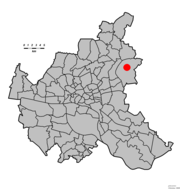Oldenfelde
| Location of Oldenfeld
in Hamburg |
Location of Oldenfeld
in Rahlstedt |
|---|---|
| Basic data | |
| State : | Hamburg |
| District : | Wandsbek |
| District : | Rahlstedt |
| Residents : | around 22,000 |
| Postal code : | 22143, 22147 |
| Area code : | 040 |
| License plate : |
HH
|
Oldenfelde ( Low German : Ollenfell ) is a part of the Hamburg district of Rahlstedt .
geography
Geographical location
Oldenfelde (pronounced with a short O) means “old field”, in this context “old, forest-free soil”. It is next Altrahlstedt , Neurahlstedt and Meiendorf one of the four districts, which together with more than 85,000 inhabitants the most populous part of Hamburg: Rahlstedt form. Oldenfelde is limited in the north by Meiendorf, in the west by the border with Farmsen-Berne in the south by Altrahlstedt and Neurahlstedt and in the east by the state border of Hamburg. The east of Oldenfeld is only sparsely populated, there is the Höltigbaum nature reserve .
geology
Oldenfeld's eastern half has a hilly formation that is caused by the meltwater flows of the glaciers from the Vistula Ice Age around 12,000 years ago. The melted glaciers left behind rubble and debris, some of which were deposited into steep walls, the Osers.
history
Oldenfelde was first mentioned in 1296 as a Holstein farming village. In the 13th and 14th centuries it was owned by the Harvestehude Monastery and the Hamburg Cathedral Chapter.
From 1326 to 1750 Oldenfelde belonged to the Trittau office. In the period from 1750 to 1773 it was a Hamburg deposit. In 1891 Oldenfelde had about 600 inhabitants. In 1893, the construction of the Altrahlstedt train station for the Lübeck-Büchener Railway and, from 1904, the small electric train from Altrahlstedt to Volksdorf increased the population. In 1903 the district of Neu-Oldenfelde was created in the area of the old customs route . In this area the houses were built faster than the streets. The residents of the area therefore found it difficult to get to their new homes via unpaved dirt roads. For this reason Neu-Oldenfelde was popularly nicknamed "Siberia". Well-to-do townspeople also moved to Oldenfelde to escape the hustle and bustle of the big city of Hamburg. In particular, they built urban villas in the Grubesallee , Bargteheider Strasse and Oldenfelder Strasse areas . Other residents followed, so that the place had around 1,300 inhabitants in 1913.
In 1927 Oldenfelde was incorporated into Rahlstedt. As part of the Greater Hamburg Act , it fell to Hamburg in 1937.
After the First and Second World Wars, many farmers sold their lands, which were used to create building sites. In the course of this development, Oldenfelde changed its face and lost the building structure that had grown over centuries, as the old farmhouses were almost completely demolished. A historical village center no longer exists.
In the 1950s and 1960s numerous buildings with social housing were built, so that the current building structure in Oldenfeld can be described as mixed and varied.
Culture and sights
Natural monument
The Hamburg part of the approximately 543 hectare Höltigbaum area is also located in the Oldenfeld borders. It is protected by the ordinance on the Höltigbaum nature reserve of May 26, 1998, the part in the Schleswig-Holstein area since 1997. In
1937 the Wehrmacht set up a parade ground here. In 1958 the Bundeswehr took over the site as a training area. In 1995 the Bundeswehr gave up the Höltigbaum as a training area.
The nature reserve, with its lush and varied hilly landscapes created in the Vistula Ice Age, offers walkers, cyclists and riders a special recreational value.
Economy and Infrastructure
traffic
Until 2015, Bargteheider Strasse was a section of Bundesstrasse 75 from Hamburg to Lübeck .
From 1904 to 1923, the small electric train ran through Oldenfelde from Altrahlstedt via Volksdorf to Wohldorf .
The long-distance railway to Lübeck and the RB81 to Ahrensburg cross Oldenfelde. The U1 runs along the Oldenfeld border and connects the district to the subway network with the Berne subway station . Since 2019 there is also the Oldenfelde underground station , which is located between the Farmsen underground station and Berne underground station.
Facilities
The Dietrich Bonhoeffer Church and the Matthias Claudius Church of the Evangelical Lutheran parish of Meiendorf-Oldenfelde are located in Oldenfelde . The Catholic parish of Rahlstedt has its seat in the Church of the Assumption on Oldenfelder Straße.
education
Oldenfelde has general education schools, throughout the school Oldenfelde , the district school Oldenfelde , the primary school Nydamer way , the school Bekassinenau and the school Kamminer road .
Literature and Sources
- Franklin Kopitzsch , Daniel Tilgner (Ed.): Hamburg Lexikon. 2nd, revised edition. Zeiseverlag, Hamburg 2000, ISBN 3-9805687-9-2 .
- Daniel Tilgner (Ed.): Hamburg from Altona to Zollenspieker. The Haspa manual for all districts of the Hanseatic city. Hoffmann and Campe, Hamburg 2002, ISBN 3-455-11333-8 .
- Our Oldenfelde - 700 years young , Bürgererverein Oldenfelde Hamburg, 1st edition 1996, ISBN 3-00-000460-2





